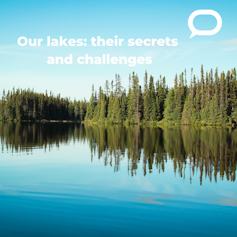Bringing about the energy transition is essential, but it will require developing a significant amount of minerals and “green” electricity, such as hydroelectricity. These activities often take place on Indigenous lands and will have environmental consequences for our lakes and rivers.
Making the energy transition will also require new infrastructure, including the development of a global fleet of electric vehicles and the installation of large wind farms and solar panels. This is already leading to high demand for minerals, mainly metals, which are now considered critical and strategic.

This article is part of our series Our lakes: their secrets and challenges. This summer, The Conversation invites you to take a fascinating dip in our lakes. With magnifying glasses, microscopes and diving goggles, our scientists scrutinize the biodiversity of our lakes and the processes that unfold in them, and tell us about the challenges they face. Don’t miss our articles on these incredibly rich bodies of water!
Given the national importance of establishing a stable supply of metals and minerals in a complex geopolitical context, many mineral-rich countries will want to encourage the development of new mines. In Canada and Québec, these mines are often spread across the Canadian Shield, reaching as far as the Far North to areas that have already been made vulnerable by climate change.
For example, studies for several rare-earth element mining projects are being carried out in the North. The first operating mine for these metals opened in 2021 near Great Slave Lake in the Northwest Territories. Similar projects are being developed in Nunavik.
Whether through mine tailings or atmospheric deposition, these mines can release a cocktail of metals into the region’s aquatic ecosystems. Often, it is not the mineral of interest that is of greatest concern but another metal extracted accidentally. This is the case with radioactive metals such as uranium and thorium, which are often extracted at the same time as rare-earth elements.
A glaring lack of data
Several of these metals have not yet been well studied in terms of ecotoxicology. That complicates the work of governments that have to establish water quality criteria with very little data at their disposal.
As professors of biological sciences at Université de Montréal and Université du Québec à Montréal, respectively, and experts in water quality, we are involved in generating the toxicological data needed to establish these criteria. In a recent study, for example, we measured the concentrations of rare-earth elements naturally present in water and animals, in order to document the effects of opening new mines.
We are also developing tools for early detection of the impact of critical and strategic metals on ecosystems. For example, we have recently used aquatic insect larvae and zooplankton as means for environmental monitoring of rare-earth elements.
In these studies, we have established that it is often the free ionic form of the metal that best explains its accumulation in animals, especially when taking into account other ions in solution that may compete with the free ion at the site of entry of the metal (for example, at the gills of invertebrates).
These results will enable our government agencies to better predict the impact of future discharges of these increasingly important contaminants.
Hydroelectric power stations on our rivers
In addition, the energy transition will require a large supply of electricity that is not dependent on fossil fuels. Hydroelectricity is a frequently chosen option, but it requires the construction of new power stations on our rivers.
As well as frequently altering the hydrological regime and biodiversity, these power stations can encourage the production of a neurotoxin, methylmercury. This production is caused by the activity of microbes that live in oxygen-poor areas, whether in land flooded by dams or in the sediments at the bottom of reservoirs.
Our recent work shows that even very small power stations such as run-of-the-river plants can cause transient increases in methylmercury in food webs all the way up to large predatory fish and their consumers, including fish-eating birds and humans.
These small power plants account for more than 90 per cent of the world’s power plants, but are rarely studied. According to some studies, their cumulative impact could be greater than that of reservoir power plants. We have also established that land disturbances upstream of power plants, such as forest fires and logging, can exacerbate neurotoxin production by allowing the transfer of mercury and organic matter to rivers.
Partnerships needed with First Peoples
As these mines and power stations are more often than not located on Indigenous lands, it is imperative to establish links of trust and communication with the communities that live there. In this context, we have developed knowledge co-creation research projects in partnership with First Peoples’ communities, industry and various universities.
These projects include the communities’ research interests, and the communities receive the research results directly. We take advantage of this research framework to promote the transfer of knowledge to communities, for example through knowledge camps where young people are invited to practise science with research teams and discover traditional knowledge with Elders.
By working together with communities, industry and governments, we believe it will be possible to develop inclusive research that will monitor the impact of the energy transition on our lakes and rivers.
Marc Amyot has received funding from NSERC, FQRNT, Canada Research Chairs, Environment and Climate Change Canada, Health Canada, four Indigenous communities and Hydro-Québec.
Maikel Rosabal has received funding from the FRQNT, NSERC and CFI. He has worked with Indigenous communities on the issue of environmental quality of lakes and rivers.
This article was originally published on The Conversation. Read the original article.







